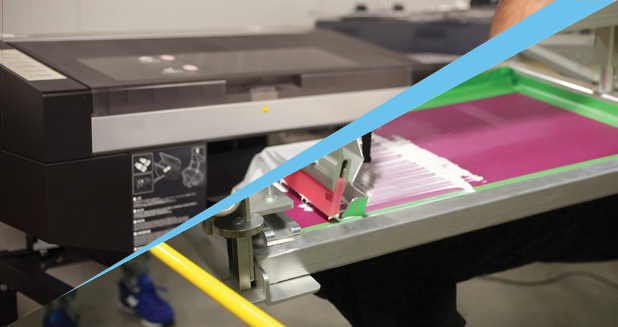
Direct to Garment vs. Screen Printing: Choosing the Right Technique for Your Project
When it comes to bringing designs to life on fabric, two popular methods stand out: Direct-To-Garment (DTG) printing and Screen Printing. Both techniques offer unique advantages and cater to different needs and preferences. In this blog post, we’ll dive into the nuances of each method to help you decide which is the best fit for your next project.
Direct to Garment (DTG) Printing: Precision and Versatility
Direct-T0-Garment printing is a relatively modern technique that works much like a traditional inkjet printer but on fabric. DTG allows for high-detail prints directly onto garments, making it an excellent choice for designs that feature intricate details or a wide range of colors.
Pros of DTG:
- High Detail: DTG excels in reproducing intricate designs with precision, offering a high level of detail that is difficult to achieve with screen printing.
Color Complexity: This method can print millions of colors, making it ideal for photographs or complex graphics. - Flexibility: With DTG, there’s no need for setup costs, making it cost-effective for small runs or single prints.
- Eco-Friendly: DTG uses water-based inks, which are generally more eco-friendly compared to the plastisol inks used in screen printing.
Cons of DTG:
- Fabric Limitations: DTG printing is primarily effective on 100% cotton garments. While advancements have been made, printing on polyester or blends might not yield the best results.
- Durability: DTG prints may not withstand wear and tear as well as screen prints, often fading faster over time and with washing.
- Cost on Larger Orders: For large quantities, DTG can be more expensive than screen printing due to the time-consuming nature of the process.
Screen Printing: Durability and Cost-Effectiveness
Screen Printing is a time-honored technique that involves creating a stencil (or “screen”) and using it to apply layers of ink onto the printing surface. Each color is applied using a different stencil, one at a time, combined to achieve the final look.
Pros of Screen Printing:
- Durability: Screen prints are known for their durability and longevity. The ink is absorbed deeply into the fabric, making it resistant to wear and washing.
- Cost-Effective for Bulk Orders: Due to the setup involved, screen printing is more cost-effective for large orders. The per-unit cost decreases significantly as the quantity increases.
- Versatility in Materials: Screen printing can be performed on a wide variety of materials including cotton, polyester, and blends.
- Vibrant Colors: This method is excellent for achieving vibrant, opaque colors, especially on dark garments.
Cons of Screen Printing:
- Setup Time and Costs: The setup process for screen printing is labor-intensive, making it less ideal for small batches or designs that require a lot of colors.
- Complexity with Multicolor Designs: Each color requires a separate screen, making intricate, multicolored designs more complex and expensive to produce.
- Less Detail: While screen printing can produce fantastic results, it may not capture the same level of detail as DTG for highly intricate designs.
Making the Choice
The decision between DTG and Screen Printing boils down to the specifics of your project. Consider the following when making your choice:
- Quantity: For small orders or samples, DTG might be more cost-effective. For large batches, screen printing is the way to go.
- Design Complexity: Multicolored, highly detailed designs may be better suited for DTG, while bold, graphic designs work well with screen printing.
- Fabric Type: DTG is best on cotton, while screen printing offers more flexibility across different materials.
- Durability Needs: If longevity is a priority, screen printing may be the better choice.
At The Graphic Hive, we’re here to guide you through these choices, ensuring your project comes out looking its best, no matter the method. Whether you’re looking to produce vibrant, detailed designs or durable, cost-effective prints in bulk, we have the expertise and technology to make it happen.
